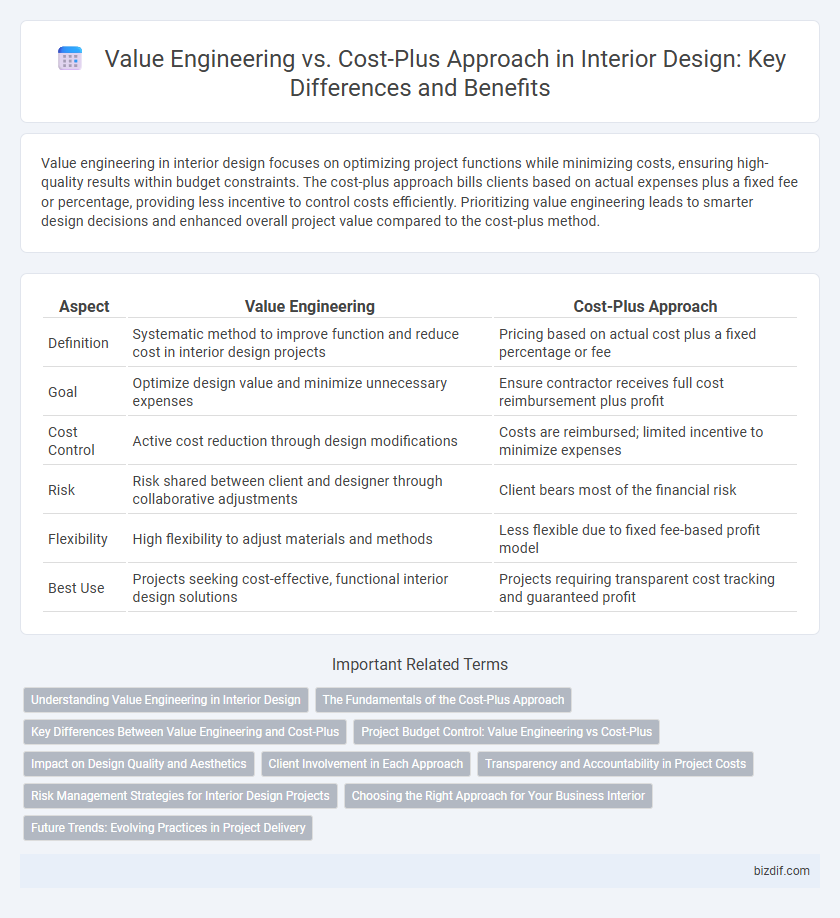Value engineering in interior design focuses on optimizing project functions while minimizing costs, ensuring high-quality results within budget constraints. The cost-plus approach bills clients based on actual expenses plus a fixed fee or percentage, providing less incentive to control costs efficiently. Prioritizing value engineering leads to smarter design decisions and enhanced overall project value compared to the cost-plus method.
Table of Comparison
| Aspect | Value Engineering | Cost-Plus Approach |
|---|---|---|
| Definition | Systematic method to improve function and reduce cost in interior design projects | Pricing based on actual cost plus a fixed percentage or fee |
| Goal | Optimize design value and minimize unnecessary expenses | Ensure contractor receives full cost reimbursement plus profit |
| Cost Control | Active cost reduction through design modifications | Costs are reimbursed; limited incentive to minimize expenses |
| Risk | Risk shared between client and designer through collaborative adjustments | Client bears most of the financial risk |
| Flexibility | High flexibility to adjust materials and methods | Less flexible due to fixed fee-based profit model |
| Best Use | Projects seeking cost-effective, functional interior design solutions | Projects requiring transparent cost tracking and guaranteed profit |
Understanding Value Engineering in Interior Design
Value engineering in interior design focuses on optimizing functionality and aesthetic appeal while minimizing costs by analyzing materials, methods, and design elements to deliver maximum value. This approach prioritizes client goals and project requirements, often resulting in innovative solutions that reduce expenses without compromising quality or style. Unlike the cost-plus approach, which adds a fixed percentage to costs, value engineering emphasizes strategic evaluation and cost-effective alternatives to achieve superior design outcomes.
The Fundamentals of the Cost-Plus Approach
The fundamentals of the cost-plus approach in interior design revolve around reimbursing the contractor for actual expenses incurred, plus an agreed-upon profit margin, ensuring transparency in project costs. This method provides flexibility to accommodate design changes and unforeseen expenses while maintaining a clear breakdown of material, labor, and overhead costs. Value engineering contrasts by systematically analyzing functions to reduce costs without sacrificing quality or aesthetics, aiming for optimized budget efficiency.
Key Differences Between Value Engineering and Cost-Plus
Value engineering in interior design focuses on optimizing project functionality and aesthetics while minimizing costs through innovative material and design choices. The cost-plus approach involves billing clients for the actual project expenses plus a fixed percentage fee, prioritizing transparency over cost reduction. Key differences include value engineering's goal to enhance value and performance versus cost-plus emphasizing cost recovery and profit margin.
Project Budget Control: Value Engineering vs Cost-Plus
Value engineering in interior design emphasizes optimizing project budget control by identifying cost-effective materials and efficient design solutions that maintain quality and functionality. The cost-plus approach offers flexibility by covering actual expenses plus a fixed fee, often leading to less predictable budget outcomes. Effective budget management in interior projects benefits from value engineering's proactive cost analysis over the reactive nature of the cost-plus method.
Impact on Design Quality and Aesthetics
Value engineering in interior design emphasizes optimizing design quality and aesthetics by identifying cost-effective materials and solutions without compromising visual appeal, resulting in innovative and functional spaces. The cost-plus approach allows designers greater freedom to select premium finishes and bespoke elements, often enhancing the overall aesthetic but potentially leading to higher expenses. Balancing value engineering with a cost-plus model can achieve a harmonious blend of budget efficiency and high-end design quality.
Client Involvement in Each Approach
Value engineering in interior design actively involves clients in identifying cost-saving materials and design efficiencies without compromising aesthetics, fostering collaborative decision-making. The cost-plus approach typically offers less client engagement during project execution, as clients pay a predetermined fee plus actual costs, limiting their influence over material or design choices. Emphasizing client involvement during value engineering leads to tailored solutions that align closely with both budget constraints and personal design preferences.
Transparency and Accountability in Project Costs
Value engineering in interior design emphasizes transparent collaboration to identify cost-saving alternatives without compromising quality, fostering accountability through detailed project cost analysis. The cost-plus approach documents expenses with a fixed fee, offering less clarity on potential cost efficiencies and limited client oversight. Transparent cost management in value engineering enhances trust and enables informed decision-making throughout the design process.
Risk Management Strategies for Interior Design Projects
Value engineering in interior design emphasizes identifying and eliminating unnecessary costs while maintaining quality, focusing on risk management through proactive design adjustments and material optimization. The cost-plus approach involves billing clients based on actual project costs plus a fixed fee, requiring thorough monitoring to manage financial risks related to scope changes and unforeseen expenses. Effective risk management in interior design projects integrates both methods by balancing cost control with transparent billing and contingency planning to mitigate budget overruns and project delays.
Choosing the Right Approach for Your Business Interior
Value engineering in interior design prioritizes optimizing materials and processes to achieve high-quality aesthetics while minimizing waste and expenses, leading to efficient project delivery and client satisfaction. The cost-plus approach involves charging clients based on actual costs plus a fixed percentage, providing transparency but potentially leading to higher overall expenses. Selecting the right method depends on project scope, budget flexibility, and desired control over design quality and cost predictability.
Future Trends: Evolving Practices in Project Delivery
Value engineering in interior design prioritizes maximizing functionality and aesthetic appeal while minimizing unnecessary expenses, leading to more sustainable and innovative project outcomes. The cost-plus approach calculates project costs with a fixed fee, offering transparency but potentially less flexibility in optimizing resource allocation. Future trends indicate a shift towards hybrid models combining value engineering's efficiency with cost-plus's clarity, supported by advanced digital tools and data analytics to enhance decision-making in project delivery.
Value engineering vs Cost-plus approach Infographic

 bizdif.com
bizdif.com